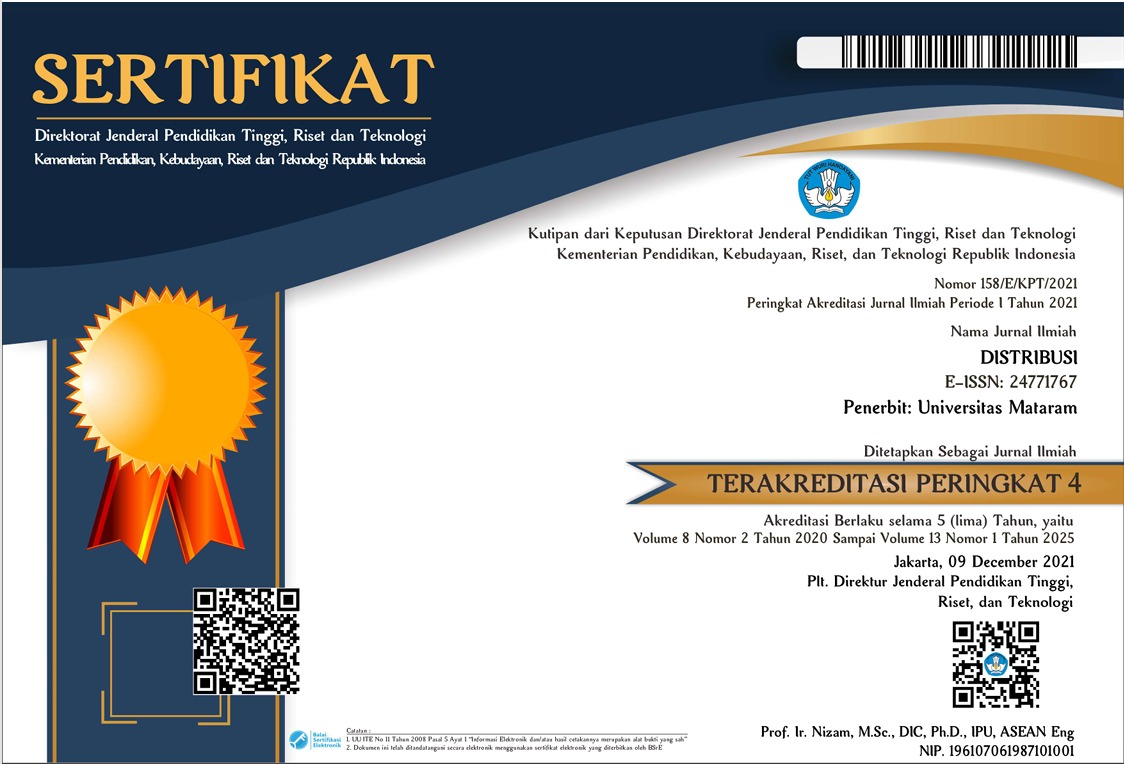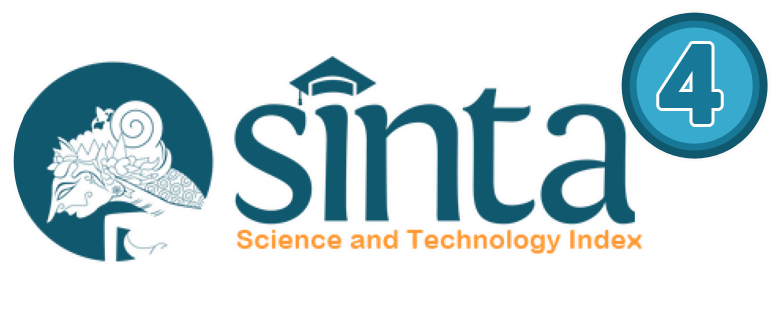IMPLIKASI PERSEPSI RISIKO, EMOSI, DAN ORIENTASI MENABUNG TERHADAP KECENDERUNGAN BERHUTANG: ADAKAH MODERASI JUMLAH TANGGUNGAN?
DOI:
https://doi.org/10.29303/distribusi.v12i1.450Keywords:
Kecenderungan Berhutang, Jumlah Tanggungan, Persepsi Risiko, Emosi, Orientasi MenabungAbstract
Perilaku berhutang seolah telah menjadi sesuatu yang umum bagi banyak masyarakat di Indonesia saat ini, terutama dengan tersedianya pinjaman berbasis teknologi. Penelitian ini bertujuan untuk menguji penentu kecenderungan berhutang yang mencakup persepsi risiko, emosi, orientasi menabung, dan jumlah tanggungan. Selain itu, penelitian ini juga mengkaji apakah jumlah tanggungan dapat memoderasi pengaruh orientasi menabung terhadap kecenderungan berhutang. Sampel penelitian 137 responden yang tinggal di kota metropolitan DKI Jakarta dan sekitarnya serta Surabaya dan sekitarnya. Teknik analisis untuk pengujian hipotesis dilakukan menggunakan Partial Least Squares (PLS) dengan software SMART-PLS. Hasil penelitian membuktikan emosi, persepsi risiko, dan jumlah tanggungan berpengaruh secara negatif signifikan pada kecenderungan berhutang, sedangkan orientasi menabung tidak berpengaruh signifikan terhadap kecenderungan berhutang. Penelitian ini tidak memperoleh bukti memadai terkait pengaruh moderasi jumlah tanggungan. Implikasi dari penelitian ini adalah bahwa individu perlu untuk menghindari perilaku yang terlalu memandang rendah risiko dari suatu keputusan keuangan dan memiliki rasa malu ketika banyak berhutang agar terhindar dari kebiasaan berhutang yang dapat menyebabkan permasalahan keuangan.
Downloads
References
Achtziger, A., Hubert, M., Kenning, P., Raab, G., & Reisch, L. (2015). Debt out of control: The links between self-control, compulsive buying, and real debts. Journal of Economic Psychology, 49, 141-149. doi: 10.1016/j.joep.2015.04.003
Ainia, N. S. N. & Lutfi, L. (2019). The influence of risk perception, risk tolerance, overconfidence, and loss aversion towards investment decision making. Journal of Economics, Business, & Accountancy Ventura, 21(3), 401-413. doi: 10.14414/jebav.v21i3.1663
Ajzen, I. (2020). The theory of planned behavior: Frequently asked questions. Human Behavior and Emerging Technologies, 2(4), 314-324. doi: 10.1002/hbe2.195
Azma, N., Rahman, M., Adeyemi, A. A., & Rahman, M. K. (2019). Propensity toward indebtedness: evidence from Malaysia. Review of Behavioral Finance, 11(2), 188-200. doi: 10.1108/RBF-05-2017-0046
Bosnjak, M., Ajzen, I., & Schmidt, P. (2020). The theory of planned behavior: Selected recent advances and applications. Europe's Journal of Psychology, 16(3), 352. doi: 10.5964/ejop.v16i3.3107
Brannon, D. C. & Manshad, M. S. (2022). Personal saving orientation is associated with higher likelihood of paying with cash versus credit: The role of financial power signaling. Personality and Individual Differences, 190, 111547. doi: 10.1016/j.paid.2022.111547
Broihanne, M.-H., Merli, M., & Roger, P. (2014). Overconfidence, risk perception and the risk-taking behavior of finance professionals. Finance Research Letters, 11(2), 64-73. doi: 10.1016/j.frl.2013.11.002
Dewanti, M. A., Yulianthini, N. N., Suarmanayasa, I. N., & Heryanda, K. K. (2023). Analisa Pengetahuan Keuangan dalam Mempengaruhi Perilaku Manajemen Keuangan dengan Pendapatan sebagai Faktor Moderasi. Bisma: Jurnal Manajemen, 9(1), 86-94. doi: 10.23887/bjm.v9i1.60957
Dholakia, U., Tam, L., Yoon, S., & Wong, N. (2016). The ant and the grasshopper: understanding personal saving orientation of consumers. Journal of Consumer Research, 43(1), 134-155. doi: 10.1093/jcr/ucw004
Flores, S. A. M. & Vieira, K. M. (2014). Propensity toward indebtedness: An analysis using behavioral factors. Journal of Behavioral and Experimental Finance, 3, 1-10. doi: 10.1016/j.jbef.2014.05.001
French, D. & McKillop, D. (2016). Financial literacy and over-indebtedness in low-income households. International Review of Financial Analysis, 48, 1-11. doi: 10.1016/j.irfa.2016.08.004
Frigerio, M., Ottaviani, C., & Vandone, D. (2020). A meta‐analytic investigation of consumer over‐indebtedness: The role of impulsivity. International journal of consumer studies, 44(4), 328-342. doi: 10.1111/ijcs.12570
Gerhard, P., Gladstone, J. J., & Hoffmann, A. O. (2018). Psychological characteristics and household savings behavior: The importance of accounting for latent heterogeneity. Journal of Economic Behavior & Organization, 148, 66-82. doi: 10.1016/j.jebo.2018.02.013
Gunasinghe, C., Gazard, B., Aschan, L., MacCrimmon, S., Hotopf, M., & Hatch, S. L. (2018). Debt, common mental disorders and mental health service use. Journal of Mental Health, 27(6), 520-528. doi: 10.1080/09638237.2018.1487541
Hair Jr, J. F., Hult, G. T. M., Ringle, C. M., & Sarstedt, M. (2021). A primer on partial least squares structural equation modeling (PLS-SEM): Sage publications.
Herdiansyah, M. F. & Himawan, K. K. (2022). Escaping the “devil's trap”: Exploring the role of online social support for fintech lending's over‐indebted Indonesian customers. International Social Science Journal, 72(245), 769-785. doi: 10.1111/issj.12348
Husna, N. A. i. & Lutfi, L. (2022). Perilaku Pengelolaan Keuangan Keluarga: Peran Moderasi Pendapatan. Jurnal Samudra Ekonomi & Bisnis, 13(1), 15-27. doi: 10.33059/jseb.v13i1.3349
Huy, Q. & Zott, C. (2019). Exploring the affective underpinnings of dynamic managerial capabilities: How managers' emotion regulation behaviors mobilize resources for their firms. Strategic Management Journal, 40(1), 28-54. doi: 10.1002/smj.2971
International Monetary Fund (2020). Household debt, loans and debt securities per GDP. Retrieved September 19, 2023, from https://www.imf.org/external/datamapper/HH_LS@GDD/THA/IDN/MYS/MMR/SGP
Iramani, R. & Lutfi, L. (2021). An integrated model of financial well-being: The role of financial behavior. Accounting, 7(3), 691-700. doi: 10.5267/j.ac.2020.12.007
Jaramillo, L., Mulas‐Granados, C., & Jalles, J. T. (2017). Debt spikes, blind spots, and financial stress. International Journal of Finance & Economics, 22(4), 421-437. doi: 10.1002/ijfe.1598
Kasoga, P. S. & Tegambwage, A. G. (2021). An assessment of over-indebtedness among microfinance institutions’ borrowers: The Tanzanian perspective. Cogent Business & Management, 8(1), 1930499. doi: 10.1080/23311975.2021.1930499
Ksendzova, M., Donnelly, G. E., & Howell, R. T. (2017). A brief money management scale and its associations with personality, financial health, and hypothetical debt repayment. Journal of Financial Counseling and Planning, 28(1), 62-75. doi: 10.1891/1052-3073.28.1.62
Lea, S. E. (2021). Debt and overindebtedness: Psychological evidence and its policy implications. Social Issues and Policy Review, 15(1), 146-179. doi: 10.1111/sipr.12074
Lee, J. M. & Hanna, S. D. (2015). Savings goals and saving behavior from a perspective of Maslow's hierarchy of needs. Journal of Financial Counseling and Planning, 26(2), 129-147. doi: 10.1891/1052-3073.26.2.129
Lestari, W. & Iramani, R. I. (2013). Persepsi risiko dan kecenderungan risiko investor individu. Jurnal Keuangan dan Perbankan, 17(1), 78-88.
Liao, J. & Liu, X. (2012). Risk and consumer debt behaviors in China. Social Behavior and Personality: an international journal, 40(8), 1263-1270. doi: 10.2224/sbp.2012.40.8.1263
Lin, Y.-C., Liu, G.-Y., Chang, C.-Y., Lin, C.-F., Huang, C.-Y., Chen, L.-W., & Yeh, T.-K. (2021). Perceived behavioral control as a mediator between attitudes and intentions toward marine responsible environmental behavior. Water, 13(5), 580. doi: 10.3390/w13050580
Loibl, C., Moulton, S., Haurin, D., & Edmunds, C. (2022). The role of consumer and mortgage debt for financial stress. Aging & Mental Health, 26(1), 116-129. doi: 10.1080/13607863.2020.1843000
Lugauer, S., Ni, J., & Yin, Z. (2019). Chinese household saving and dependent children: Theory and evidence. China Economic Review, 57, 101091. doi: 10.1016/j.chieco.2017.08.005
Luo, S., Sun, Y., & Zhou, R. (2022). Can fintech innovation promote household consumption? Evidence from China family panel studies. International Review of Financial Analysis, 82, 102137. doi: 10.1016/j.irfa.2022.102137
Mandell, L. & Klein, L. S. (2009). The impact of financial literacy education on subsequent financial behavior. Journal of Financial Counseling and Planning, 20(1). doi: 15-24
Muñoz-Murillo, M., Álvarez-Franco, P. B., & Restrepo-Tobón, D. A. (2020). The role of cognitive abilities on financial literacy: New experimental evidence. Journal of Behavioral and Experimental Economics, 84, 101482. doi: 10.1016/j.socec.2019.101482
Oksanen, A., Aaltonen, M., & Rantala, K. (2015). Social determinants of debt problems in a Nordic welfare state: A Finnish register-based study. Journal of consumer policy, 38, 229-246. doi: 10.1007/s10603-015-9294-4
Pompian, M. (2016). Risk profiling through a behavioral finance lens: CFA Institute Research Foundation.
Ponchio, M. C., Cordeiro, R. A., & Gonçalves, V. N. (2019). Personal factors as antecedents of perceived financial well-being: evidence from Brazil. International Journal of Bank Marketing, 37(4), 1004-1024. doi: 10.1108/IJBM-03-2018-0077
Rabbani, A. G., Yao, Z., Wang, C., & Grable, J. E. (2021). Financial Risk Tolerance, Sensation Seeking, and Locus of Control Among Pre-Retiree Baby Boomers. Journal of Financial Counseling and Planning, 32(1), 146-157. doi: 10.1891/JFCP-18-00072
Rahman, M., Albaity, M., & Isa, C. R. (2020). Behavioural propensities and financial risk tolerance: the moderating effect of ethnicity. International Journal of Emerging Markets, 15(4), 728-745. doi: 10.1108/IJOEM-01-2018-0024
Rahman, M., Lim, N. A. A., Masud, M., Kaium, A., & Ismail, Y. (2020). Determinants of indebtedness: Influence of behavioral and demographic factors. International Journal of Financial Studies, 8(1), 1-13. doi: 10.3390/ijfs8010008
Selvaraja, M. & Abdullah, A. (2020). Psychological Factors’ Influence on Consumers’ Propensity to Indebtedness Applying the Behavioural Economic Theory. Journal of Business and Economics, 11(2), 165-172.
Shohib, M. (2015). Sikap terhadap uang dan perilaku berhutang. Jurnal Ilmiah Psikologi Terapan, 3(1), 132–143-132–143. doi: 10.22219/jipt.v3i1.2133
Simon, M., Houghton, S. M., & Aquino, K. (2000). Cognitive biases, risk perception, and venture formation: How individuals decide to start companies. Journal of business venturing, 15(2), 113-134. doi: 10.1016/S0883-9026(98)00003-2
Tay, L., Batz, C., Parrigon, S., & Kuykendall, L. (2017). Debt and subjective well-being: The other side of the income-happiness coin. Journal of Happiness Studies, 18, 903-937. doi: 10.1007/s10902-016-9758-5
Vieira, K. M., de Oliveira, M. O. R., & Kunkel, F. I. R. (2016). The credit card use and debt: is there a trade-off between compulsive buying and ill-being perception? Journal of Behavioral and Experimental Finance, 10, 75-87. doi: 10.1016/j.jbef.2016.03.001
Wahono, H. K. & Pertiwi, D. (2020). Pengaruh financial literacy, materialism, compulsive buying terhadap propensity to indebtedness. International Journal of Financial and Investment Studies (IJFIS), 1(1), 1-14. doi: 10.9744/ijfis.1.1.1-14
Widjajaa, I., Arifina, A. Z., & Setinib, M. (2020). The effects of financial literacy and subjective norms on saving behavior. Management Science Letters, 10, 3635–3642. doi: 10.5267/j.msl.2020.6.030
Wulandari, D. A. & Iramani, R. (2014). Studi Experienced Regret, Risk Tolerance, Overconfidance Dan Risk Perception Pada Pengambilan Keputusan Investasi. Journal of Business and Banking, 4(1), 55-66. doi: 10.14414/jbb.v4i1.293
Xiao, J. J. & Kim, K. T. (2022). The able worry more? Debt delinquency, financial capability, and financial stress. Journal of family and economic Issues, 43(1), 138-152. doi: 10.1007/s10834-021-09767-3
Downloads
Published
How to Cite
Issue
Section
License
Copyright (c) 2024 Arlianti Agil Susilowati, Lutfi Lutfi

This work is licensed under a Creative Commons Attribution-ShareAlike 4.0 International License.
Penulis yang naskahnya diterbitkan menyetujui ketentuan sebagai berikut:
- Hak publikasi atas semua materi naskah jurnal yang diterbitkan/dipublikasikan dalam situs Jurnal DISTRIBUSI ini dipegang oleh dewan redaksi dengan sepengetahuan penulis (hak moral tetap milik penulis naskah).
- Ketentuan legal formal untuk akses artikel digital jurnal elektronik ini tunduk pada ketentuan lisensi Creative Commons Attribution-ShareAlike (CC BY-SA), yang berarti Jurnal DISTRIBUSI berhak menyimpan, mengalih media/format-kan, mengelola dalam bentuk pangkalan data (database), merawat, dan mempublikasikan artikel tanpa meminta izin dari Penulis selama tetap mencantumkan nama Penulis sebagai pemilik Hak Cipta.
- Naskah yang diterbitkan/dipublikasikan secara cetak dan elektronik bersifat open access untuk tujuan pendidikan, penelitian, dan perpustakaan. Selain tujuan tersebut, dewan redaksi tidak bertanggung jawab atas pelanggaran terhadap hukum hak cipta.









